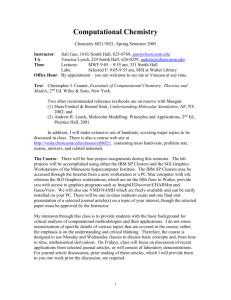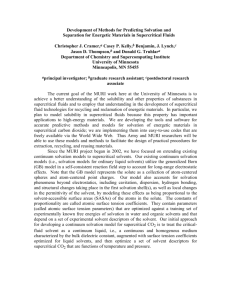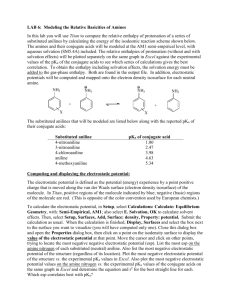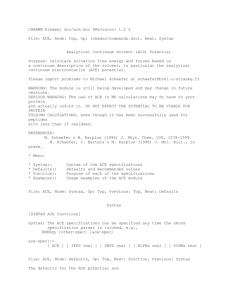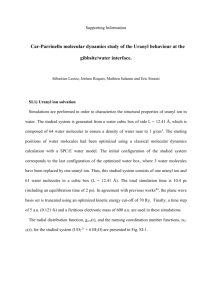CHARMM Element doc/eef1 $Revision: 1.4 $ File: EEF1, Node
advertisement
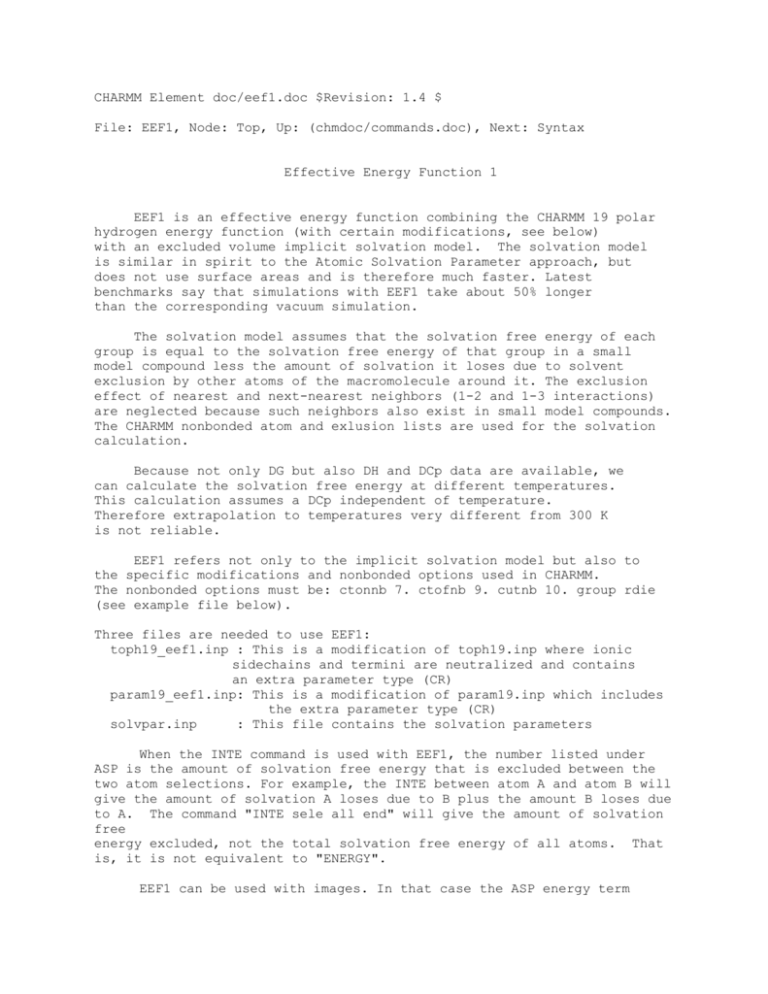
CHARMM Element doc/eef1.doc $Revision: 1.4 $ File: EEF1, Node: Top, Up: (chmdoc/commands.doc), Next: Syntax Effective Energy Function 1 EEF1 is an effective energy function combining the CHARMM 19 polar hydrogen energy function (with certain modifications, see below) with an excluded volume implicit solvation model. The solvation model is similar in spirit to the Atomic Solvation Parameter approach, but does not use surface areas and is therefore much faster. Latest benchmarks say that simulations with EEF1 take about 50% longer than the corresponding vacuum simulation. The solvation model assumes that the solvation free energy of each group is equal to the solvation free energy of that group in a small model compound less the amount of solvation it loses due to solvent exclusion by other atoms of the macromolecule around it. The exclusion effect of nearest and next-nearest neighbors (1-2 and 1-3 interactions) are neglected because such neighbors also exist in small model compounds. The CHARMM nonbonded atom and exlusion lists are used for the solvation calculation. Because not only DG but also DH and DCp data are available, we can calculate the solvation free energy at different temperatures. This calculation assumes a DCp independent of temperature. Therefore extrapolation to temperatures very different from 300 K is not reliable. EEF1 refers not only to the implicit solvation model but also to the specific modifications and nonbonded options used in CHARMM. The nonbonded options must be: ctonnb 7. ctofnb 9. cutnb 10. group rdie (see example file below). Three files are needed to use EEF1: toph19_eef1.inp : This is a modification of toph19.inp where ionic sidechains and termini are neutralized and contains an extra parameter type (CR) param19_eef1.inp: This is a modification of param19.inp which includes the extra parameter type (CR) solvpar.inp : This file contains the solvation parameters When the INTE command is used with EEF1, the number listed under ASP is the amount of solvation free energy that is excluded between the two atom selections. For example, the INTE between atom A and atom B will give the amount of solvation A loses due to B plus the amount B loses due to A. The command "INTE sele all end" will give the amount of solvation free energy excluded, not the total solvation free energy of all atoms. That is, it is not equivalent to "ENERGY". EEF1 can be used with images. In that case the ASP energy term refers to the solvation free energy of the primary atoms. This is usually less negative than when images are not present, because image atoms exclude some solvation free energy from the primary atoms. EEF1 is compatible with the BYCC non-bonded option and the NBACtive command, so that the calculation of non-bonded and solvation energy terms can be limited to specific subsets of atoms in the system. * Menu: * Syntax:: * References:: * Example:: Syntax of the EEF1 commands Useful references Input file File: EEF1, Node: Syntax, Up: Top, Next: References, Previous: Top Syntax for EEF1 There are only two EEF1 commands: EEF1 SETUP [TEMP real] UNIT int NAME solv_param_file EEF1 PRINT The first sets up the solvation calculation by giving TEMP and reading in the solvation parameters. And the second prints out the solvation of each group. The solvation energy is stored in ETERM(ASP) and reported under the name "ASP". Obviously, it makes no sense to use both ASP and EEF1. If one wants to skip the solvation term after one has set it up, one can issue the command SKIP ASP. TEMP PRINT is the temperature to which the solvation parameters refer to (default is 298.15). Note that this is unrelated to the temperature at which one runs dynamics. It just determines the solvation free energy parameter values. prints out the solvation free energy of each atom/group as well as the solvation enthalpy and heat capacity File: EEF1, Node: References, Up: Top, Next: Example, Previous: Syntax References [1] T. Lazaridis and M. Karplus, Effective energy function for proteins in solution, Proteins, 35:133-152 (1999) [2] T. Lazaridis and M. Karplus, Discrimination of the native from misfolded protein models with an energy function including implicit solvation, J. Mol. Biol., 288:477-487 (1999) [3] T. Lazaridis and M. Karplus, "New View of Protein Folding reconciled with the Old through Multiple Unfolding Simulations", Science, 278:1928 (1997) File: EEF1, Node: Example, Up: Top, Next: Top, Previous: References --------------------------------------------------------------------* Example file for EEF1 * open read card unit 3 name toph19_eef1.inp read rtf unit 3 card close unit 3 open read card unit 3 name param19_eef1.inp read para unit 3 card close unit 3 open read unit 3 card name filename.crd read seque coor unit 3 close unit 3 generate main setup open read unit 2 card name filename.crd read coor card unit 2 close unit 2 ! IMPLICIT SOLVATION SETUP COMMAND ! The nonbonded options below are part of the model eef1 setup temp 298.15 unit 93 name solvpar.inp update ctonnb 7. ctofnb 9. cutnb 10. group rdie mini abnr nstep 300 !This command prints out solvation free energy for each atom eef1 print dynamics verlet timestep 0.002 nstep 1000 nprint 100 iprfrq 100 firstt 240 finalt 300 twindh 10.0 ieqfrq 200 ichecw 1 iasors 0 iasvel 1 inbfrq 20 inte sele resid 2 end sele resid 19 end !the command below is not equivalent to energy inte sele all end energy skip asp energy stop


